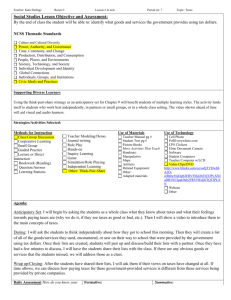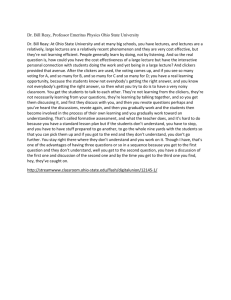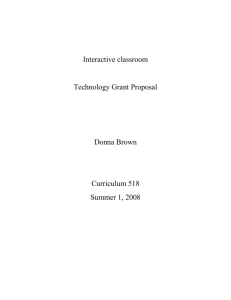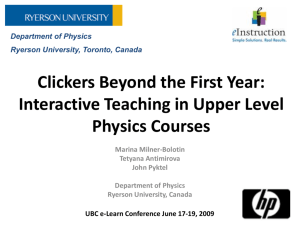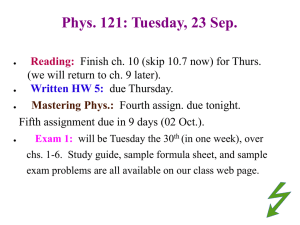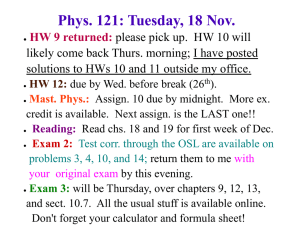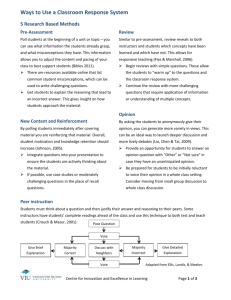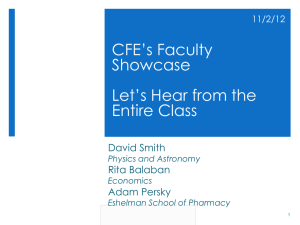AME handout-final
advertisement
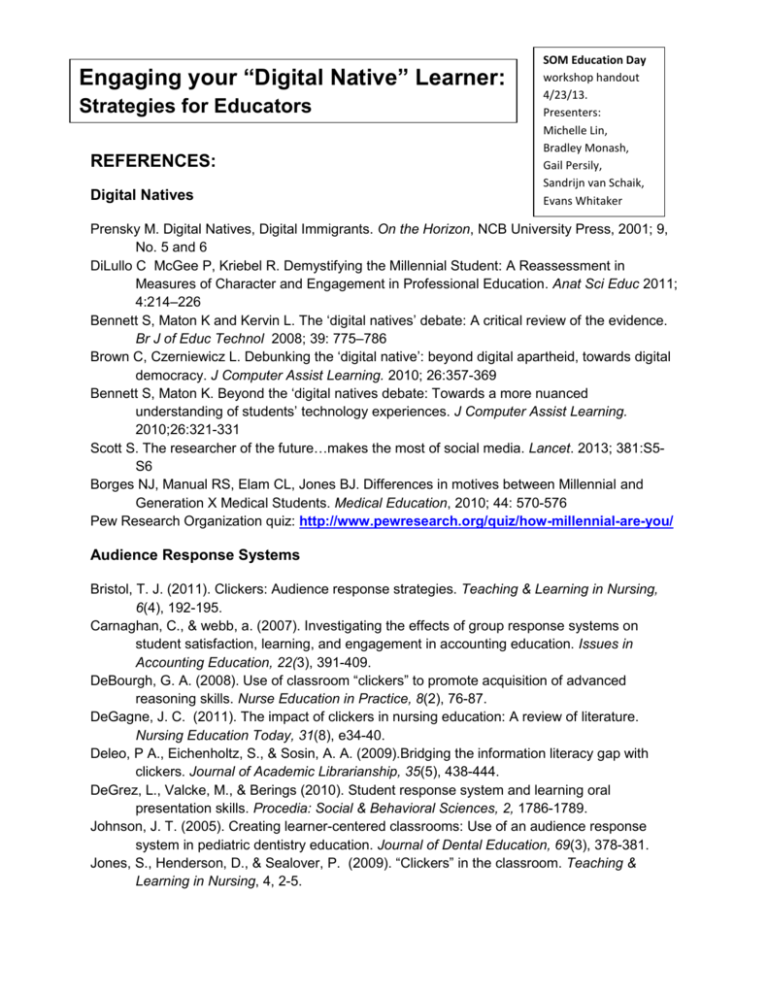
Engaging your “Digital Native” Learner: Strategies for Educators REFERENCES: Digital Natives SOM Education Day workshop handout 4/23/13. Presenters: Michelle Lin, Bradley Monash, Gail Persily, Sandrijn van Schaik, Evans Whitaker Prensky M. Digital Natives, Digital Immigrants. On the Horizon, NCB University Press, 2001; 9, No. 5 and 6 DiLullo C McGee P, Kriebel R. Demystifying the Millennial Student: A Reassessment in Measures of Character and Engagement in Professional Education. Anat Sci Educ 2011; 4:214–226 Bennett S, Maton K and Kervin L. The ‘digital natives’ debate: A critical review of the evidence. Br J of Educ Technol 2008; 39: 775–786 Brown C, Czerniewicz L. Debunking the ‘digital native’: beyond digital apartheid, towards digital democracy. J Computer Assist Learning. 2010; 26:357-369 Bennett S, Maton K. Beyond the ‘digital natives debate: Towards a more nuanced understanding of students’ technology experiences. J Computer Assist Learning. 2010;26:321-331 Scott S. The researcher of the future…makes the most of social media. Lancet. 2013; 381:S5S6 Borges NJ, Manual RS, Elam CL, Jones BJ. Differences in motives between Millennial and Generation X Medical Students. Medical Education, 2010; 44: 570-576 Pew Research Organization quiz: http://www.pewresearch.org/quiz/how-millennial-are-you/ Audience Response Systems Bristol, T. J. (2011). Clickers: Audience response strategies. Teaching & Learning in Nursing, 6(4), 192-195. Carnaghan, C., & webb, a. (2007). Investigating the effects of group response systems on student satisfaction, learning, and engagement in accounting education. Issues in Accounting Education, 22(3), 391-409. DeBourgh, G. A. (2008). Use of classroom “clickers” to promote acquisition of advanced reasoning skills. Nurse Education in Practice, 8(2), 76-87. DeGagne, J. C. (2011). The impact of clickers in nursing education: A review of literature. Nursing Education Today, 31(8), e34-40. Deleo, P A., Eichenholtz, S., & Sosin, A. A. (2009).Bridging the information literacy gap with clickers. Journal of Academic Librarianship, 35(5), 438-444. DeGrez, L., Valcke, M., & Berings (2010). Student response system and learning oral presentation skills. Procedia: Social & Behavioral Sciences, 2, 1786-1789. Johnson, J. T. (2005). Creating learner-centered classrooms: Use of an audience response system in pediatric dentistry education. Journal of Dental Education, 69(3), 378-381. Jones, S., Henderson, D., & Sealover, P. (2009). “Clickers” in the classroom. Teaching & Learning in Nursing, 4, 2-5. Nelson, C., Hartling, L., Campbell, S., & Oswald, A. E. (2012). The effects of audience response systems on learning outcomes in health professions education. A BEME systematic review: BEME Guide No. 21. Medical teacher, 34(6), e386–405. doi:10.3109/0142159X.2012.680938 http://informahealthcare.com/doi/abs/10.3109/0142159X.2012.680938 Patterson, B., Kilpatrick, J., & Woebkenberg, E. (2010). Evidence for teaching practice; The impact of clickers in a large classroom environment. Nurse Education Today, 30(7), 603607. Premkumar, K., & Coupal,C. (2008). Rules of engagement-12 tips for successful use of clickers in the classroom. Medical Teacher, 30(2), 146-149. Russell, J. S.,McWilliams, M., Chasen, L., & Farley, J. (2011). Using clickers for clinical reasoning and problem solving. Nurse Educator, 36(1), 13-15. Thomas, C., Monturo, C., & Conroy, K. (2011). Experience of fauclty and students using audience response system in the classroom. CIN: Computers, Informatics, Nursing, 29(7), 396-400. Vana, K. D., Silva, G. E., Muzka, D., & Hirani, L. M. (2011). Effectiveness of an audience response system in teaching pharmacology to baccalaureate nursing students. CIN: Computers, Informatics, Nursing, 29, TC105-TC113. Wood, W. B. (2004). Clickers: A teaching gimmick that works. Developmental Cell, 7(6), 796798. Presentation Software -- Information and philosophy An excellent local resource is Sean McClelland from the Learning Technologies Group. We will provide a PDF of the handout to his excellent class (The Better Presenter) to those interested. It is 6 pages full of useful information about presentations. See Sean’s blog for related information blogs.library.ucsf.edu/betterpresenter/ http://www.presentationzen.com/, particularly http://presentationzen.blogs.com/presentationzen/2005/09/whats_good_powe.html Mayer, R. E.; R. Moreno (1998). “A Cognitive Theory of Multimedia Learning: Implications for Design Principles”. http://www.unm.edu/~moreno/PDFS/chi.pdf. Issa N, Mayer RE, Schuller M, Wang E, Shapiro MB, Darosa DA. Teaching for understanding in medical classrooms using multimedia design principles. Med Educ. 2013 Apr;47(4):388-96. doi: 10.1111/medu.12127. PubMed PMID: 23488758. Twitter in Education Forgie SE, Duff JP, Ross S. Twelve tips for using Twitter as a learning tool in medical education. Med Teach. 2013; 35(1):8-14. Hollinderbäumer A, Hartz T, Uckert F.Education 2.0 -- how has social media and Web 2.0 been integrated into medical education? A systematical literature review. GMS Z Med Ausbild. 2013;30(1):Doc14. doi: 10.3205/zma000857. Epub 2013 Feb 21. Free PMC Article

